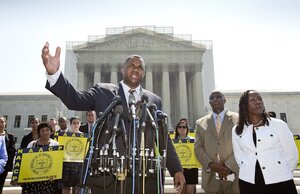Supreme Court ruling hardly ends the issue in Voting Rights Act
In the Supreme Court ruling on the Voting Rights Act, the nine justices were at odds over an issue that still divides America: How to deal with old fears of any new types of racism.

Ryan Haygood, director of the NAACP Legal Defense Fund, talks outside the Supreme Court June 25 about the Shelby County v. Holder, a voting rights case in Alabama.The high court says a key provision of the law cannot be enforced until Congress comes up with a new way of determining which states and localities require close federal monitoring of voting procedures.
AP Photo
In a ruling Tuesday, the US Supreme Court threw out a key provision of the Voting Rights Act, reopening a debate over how much discrimination exists among certain elected officials in possibly denying minorities access to the polling booth.
The ruling strikes down the act’s selective treatment of 15 states or counties – mainly in the South – that had been found guilty of past discrimination against black voters. Since 1965, these jurisdictions have had to seek federal approval for any proposed changes to their local voting procedures. The high court found little or no evidence of current guilt to justify this continuing treatment, especially compared with states not covered by the law.
The Constitution, the court stated, requires that states be treated with equality in their sovereignty over voting matters unless they violate basic federal rights. The court left intact the act’s ability to correct cases of such discrimination in the future.
In essence, the five conservative justices in the majority asserted a presumption of innocence while the dissenting four justices warned that the act’s provision is still needed as a deterrent against a recurrence of new types of racism in voting policies.
In the court’s ruling, Chief Justice John Roberts argued that the provision relies “on decades-old data relevant to decades-old problems, rather than current data reflecting current needs.” In the dissenting view, Justice Ruth Bader Ginsburg countered that “the prospect of retrogression” is real, citing “second-generation barriers” to the ballot box for blacks.
“Throwing out [the provision for federal approval] when it has worked and is continuing to work to stop discriminatory changes is like throwing out your umbrella in a rainstorm because you are not getting wet,” she wrote.
These different perceptions about how much racism persists in government brings to mind several remarks by Barack Obama.
In a famous speech in 2008, then-candidate Obama criticized his long-term Chicago pastor, Jeremiah Wright, by saying:
“The profound mistake of Reverend Wright’s sermons is not that he spoke about racism in our society. It’s that he spoke as if our society was static; as if no progress has been made; as if this country – a country that has made it possible for one of his own members to run for the highest office in the land and build a coalition of white and black, Latino and Asian, rich and poor, young and old – is still irrevocably bound to a tragic past.”
But after Tuesday’s ruling, President Obama said he was “deeply disappointed” in the court’s decision, saying discrimination still exists – although not specifying whether it is only in those selected states or can exist anywhere.
His response illustrates the basic issue – whether a fear of racism and of possible backsliding in voting rights, even if based on little or no evidence, is enough to justify preemptive action against states with a history of racism.
Other issues swirl around the Voting Rights Act, such as whether its use to create voting districts with black majorities still serves to elevate the interests of blacks. But the issue of whether racism is a hidden reality that needs constant watch or merely something that needs correction when proved is something deeper than one court ruling.
This ruling hardly resolves this tension in American society. But it at least serves to bring to light a lingering fear that needs to be addressed. In fact, the passion expressed by the nine justices in their clashing opinions shows just how much work remains to be done on race relations.

